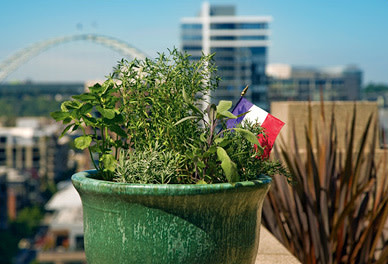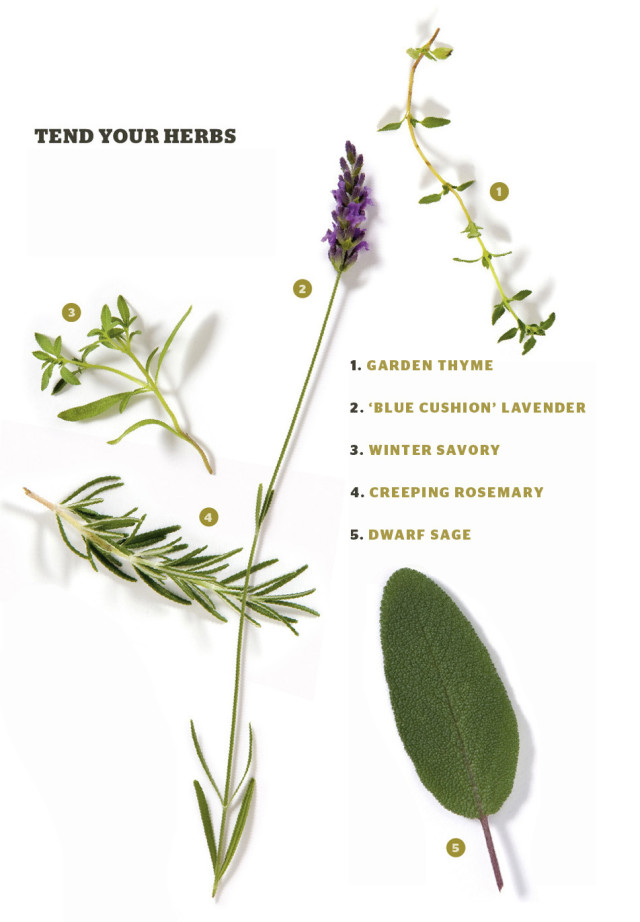Herbal Infusion

When the rains arrive and the temperature drops, we Portlanders tend to curl up next to a warm indoor fire and seek solace in the season’s comfort foods. Autumn favorites like creamy mashed potatoes, roast chicken, and stuffings of all kinds are taken to a new level when seasoned with fresh herbs—piney, richly assertive rosemary; warm, fragrant sage; and crisp, minty garden thyme. And when “fresh” translates to “picked 30 seconds ago from your own herb garden,” the experience is that much more rewarding.
City dwellers who don’t have access to a yard, or who simply don’t have the time to nourish a full-scale garden, often are discouraged from growing their own food. An evergreen herb garden, however, requires little space, even less maintenance, and will provide flavorful additions to your culinary creations year-round. Luckily, Portland’s mild climate, coupled with herbs’ general hardiness, makes for ideal outdoor planting conditions well into November. Most culinary herbs thrive in full sun, making south-facing balconies or porches the perfect spot to plant, though they will grow in partial shade as well.
{page break}
Herb Hunt
If you’re just starting a balcony garden, Penny Hanselman, proprietor (with husband Mike and daughter Heather) of Blue Heron Herbary on Sauvie Island (27731 NW Reeder Rd, blueheronherbary.com), recommends starting with a simple selection of five classic evergreen herbs—garden thyme, creeping rosemary, ‘Blue Cushion’ lavender, dwarf sage, and winter savory (see “Tend Your Herbs,” next page)—to create a beautiful planter that will provide delectable ingredients and garnishes while decorating your deck through the winter.
To create the planter suggested by Hanselman, you’ll want to buy herb starts in 3- to 4-inch pots instead of starting from seeds. Local farmers markets are the best places to shop for fresh varieties—the Portland Farmers Market (portlandfarmersmarket.org), Hillsdale Farmers Market (hillsdalefarmersmarket.com), and Beaverton Farmers Market (beavertonfarmersmarket.com) all have good selections most of the year.
When selecting plants, look for healthy foliage and avoid brown, wilting, or crunchy leaves. With herbs, scent equals taste, so gently rub the leaves between your fingers and savor the aroma to make sure you are selecting a variety that would complement your cooking. Hanselman’s favorites are variegated lemon thyme (Thymus citriodorus ‘Variegatus’), for its heady, lemony scent; and Arp rosemary (Rosmarinus officinalis ‘Arp’), for its culinary versatility.
Tend your herbs
Penny Hanselman of Blue Heron Herbary says that herbs are quite resilient and can thrive even in poor conditions. Still, here are a few usage and plant-care tips for getting the most out of your pot of herbs.
1. Garden thyme

(Thymus vulgaris): Thyme is great in sauces, soups, and stews, or added to a salad for an unexpected twist. Clip three times over the summer, removing the top 3 to 4 inches.
2. ‘Blue Cushion’ lavender
(Lavandula angustifolia ‘Blue Cushion’): Lavender flowers can be dried for potpourri or chopped finely to add flavor to shortbread or sugar cookies. Cut stems back when the flowers die.
3. Winter savory
(Satureja montana): With its distinct, piquant scent, savory is a great addition to your culinary tool kit, especially when sprinkled over fresh green beans. Trim the plant to keep it bushy.
4. Creeping rosemary
(Rosmarinus officinalis ‘Prostrates’): This staple will dress up your vegetables or lamb, and its stalks work quite well as kabob sticks. Shape it a little, but don’t clip it back very much.
5. Dwarf sage
(Salvia officinalis): With its robust flavor, a little fresh sage will add color and flavor to both your balcony and your turkey dishes. Prune as needed to keep the plant compact.
{page break}
Pick and Prep the Pots
Although most herbs can be grown in perforated ceramic pots, terra-cotta pots, or even window boxes, Hanselman recommends using round plastic pots for your herbs, as they hold more soil, give herbs plenty of room to grow, hold water better than clay pots, and are lightweight and easier to move. They also won’t dry out as fast as narrow trays or windowsill planters. The size of the pot you need depends on your selection of herbs, but a pot 12 inches in diameter and 12 inches deep should hold the five herbs recommended for this project.
Fill your 12-inch pot roughly 7½ inches deep with soil. Any standard potting-soil mix will do, but if you prefer to grow organically, opt for something like Whitney Farms Premium Potting Soil ($5 per cubic foot at Portland Nursery, portlandnursery.com). Space the root balls of the herbs equidistant from one another and from the sides of the pot. Cover the roots completely, making sure to keep the dirt ½ inch from the top rim of the pot.
Daily Drink
The beauty of herbs, according to Hanselman, is that “they just grow like weeds”—a boon to the absentminded gardeners among us. Herbs will, however, need to be watered. Hanselman waters hers about once a day. When the weather is warm, water in the morning before the sun is out in full force; in the evening, wait until it has cooled off to avoid evaporation. To gauge whether your herbs need water, press your finger into the soil—it should be moist, but not soaking wet. Herbs will need less watering as the weather cools and the winter rains arrive.
Get Cooking
Whenever you need them, pick sprigs of fresh herbs from the top of the plant, where leaves are forming on the stem. Pick after 11 a.m.—by this time of day, the sun will have shed enough light on the plant to draw out the natural oils, which carry the herbs’ scent and flavor.
When drying herbs at the end of summer, either for gifts or later use, pick sprigs in the morning. Snip, wash, pat dry, and hang in a warm, dark, dry place. Check periodically over the course of one to three weeks—if the leaves crumble off the stem, they’ve dried long enough. Strip the leaves and place them in an airtight container, labeled and dated. They’ll keep for up to a year.
Once you start using your herbs, the possibilities are endless. Spend your winter feasting on rosemary chicken, sage-spiced pork, savory stuffing, lavender jelly, and other recipes you’ve looked up or dreamed up. Despite the gray skies and wet weather, your winter will be warmed and brightened by herb-inspired comfort foods.
